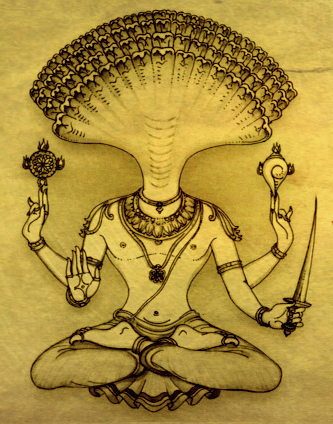– English version below –

La pratica di asana (posture) dell’Ashtanga Yoga inizia tradizionalmente con un canto e termina con un altro canto. I canti (noti anche come mantra o invocazioni) sono offerti in sanscrito, dal momento che questa è la lingua in cui sono stati composti anche se da autori diversi.
L’atto del “cantare i mantra” è ritenuto capace di elevare il grado di consapevolezza dell’individuo che lo compie portandolo ad un livello più alto, più vicino alla sua vera Essenza. Tale atto, inoltre, è fortemente correlato con il respiro e produce un effetto calmante, lasciando il praticante centrato e in uno stato di pace e di quiete.
Ora, se reciti questi 2 mantra una volta a settimana o meno potresti non sentire tutti questi benefici 🙂 Ciononostante, se lo fai quotidianamente, arriverà un momento in cui comincerai a sentirne gli effetti positivi. In particolare, e anche sulla base della mia esperienza personale:
-> il mantra iniziale diventa una porta di accesso ad un certo spazio interiore, preparandoti per la pratica degli asana con la consapevolezza che ciò che stai per fare va al di là dell’aspetto puramente fisico. In aggiunta, è un modo per esprimere la propria gratitudine verso il lineaggio e i migliaia di insegnanti che hanno trasmesso lo yoga nel corso dei secoli, consentendoci oggi di conoscerlo e praticarlo, nonchè godere dei suoi benefici;
-> il mantra finale è un’offerta di qualsiasi merito che abbiamo guadagnato attraverso la nostra pratica sul tappetino per uno scopo più alto, aiutandoci a sviluppare amore e benevolenza verso il prossimo.
Ma guardiamo ora in dettaglio il testo e il corrispondente significato dell’invocazione iniziale e della ‘preghiera’ finale.
ASHTANGA YOGA MANTRA INIZIALE

Traduzione:
Mi inchino ai piedi del supremo guru
che insegna la via per conoscere la grande felicità dell’auto-realizzazione del sé,
come un guaritore della giungla elimina l’illusione
e il veleno dell’ignoranza del samsara (esistenza condizionata) |
dalla parte superiore del corpo di aspetto umano,
porta con sé una conchiglia (il suono divino), un disco (il tempo infinito) e una spada (la discriminazione).
Io mi inchino a Patanjali, incoronato da un cobra dalle mille teste bianche | |
ASHTANGA YOGA MANTRA FINALE

Traduzione:
Possa l’umanità prosperare
e i potenti della terra governarla
camminando sul sentiero della giustizia,
possa l’universo essere buono con tutti coloro
che riconoscono la sacralità della terra,
e tutti i popoli della terra vivere nella gioia.
Clicca sui due link di seguito per ascoltarli recitati da Pattabhi Jois:
ASHTANGA YOGA OPENING AND CLOSING MANTRAS. WHY TO CHANT AND THEIR MEANINGS.
Ashtanga Yoga asana practice traditionally starts with an opening chant and ends with a closing one. The chants (also known as mantras or invocations) are offered in Sanskrit, as this is the language they were all originally composed in, though they have different authors.
The act of chanting is said to be able to elevate the consciousness of the individual performing it to a higher level, closer to its Source. It is also strongly correlated with the breath, which has a soothing and calming effect, leaving the practitioner self-centered and at peace.
Now, you may not be able to experience all of those benefits if you chant them once a week or even less 🙂 Nonetheless, if you chant them daily there will come a time when you will start feeling the benefits. Specifically, and also according to my own personal experience:
-> the opening mantra becomes a trigger to access a certain space within, preparing yourself for the asana practice with the understanding that what you are performing is more than just physical. Moreover, it’s a way to show the gratitude towards the lineage and the thousands of teachers who have transmitted yoga over centuries, allowing us to get to know it;
-> the closing mantra is an offering of whatever merits we have acquired through the practice to a higher purpose, developing love and kindness for others.
But, let’s see in detail the text and the meaning of the opening and closing prayers.
ASHTANGA YOGA OPENING CHANT

English translation:
I bow to the feet of the Guru, which awaken insight
into the happiness of pure Being, which are
the complete absorbtion into joy,
the jungle physician, eliminating the delusion
caused by the poison of Samsara (conditioned existence) |
I prostrate before the sage Patanjali
who has thousands of radiant white heads (in the form of the divine serpent, Ananta)
and a human form up to the shoulders,
who holds a conch shell (divine sound), a wheel (a discus of light or time)
and a sword (discrimination) | |
ASHTANGA YOGA CLOSING CHANT

English translation:
May all of humankind be happy and well.
May the leaders protect the earth in every way by the path of just virtue.
May there be goodness for those who know the earth to be sacred.
May all the worlds be happy.
Listen to Pattabhi Jois reciting them here:

